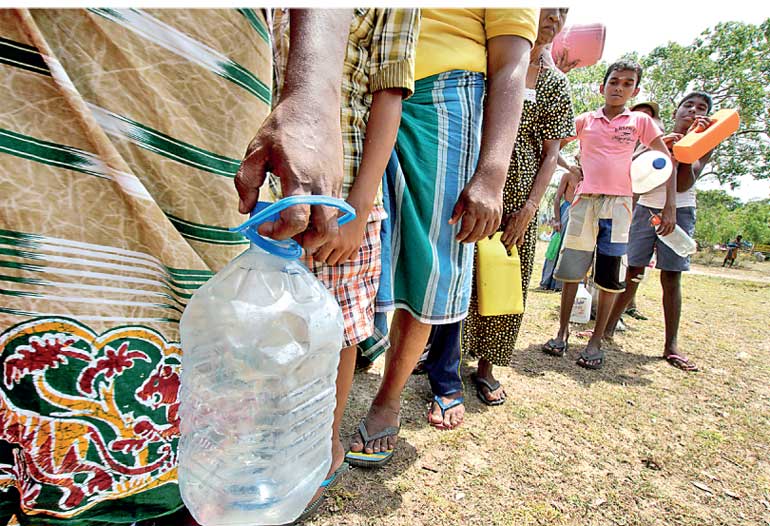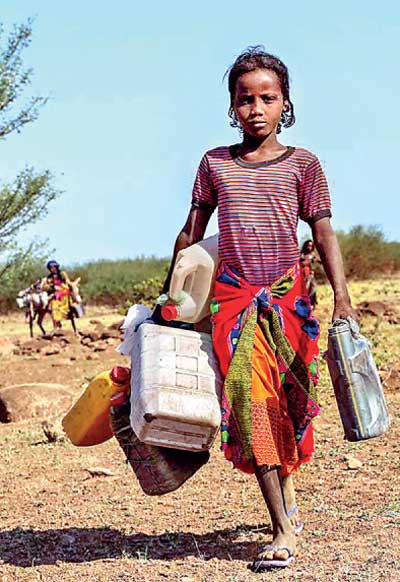Thursday Apr 25, 2024
Thursday Apr 25, 2024
Wednesday, 22 March 2017 00:03 - - {{hitsCtrl.values.hits}}
Some 600 million children – or 1 in 4 children worldwide – will be living in areas with extremely limited water resources by 2040, according to a UNICEF report released on World Water Day.
The report, Thirsting for a Future: Water and children in a changing climate, looks at the threats to children’s lives and wellbeing caused by depleted sources of safe water and the ways climate change will intensify these risks in coming years.
According to the report, 36 countries are currently facing extremely high levels of water stress, which occurs when demand for water far exceeds the renewable supply available. Warmer temperatures, rising sea levels, increased floods, droughts and melting ice affect the quality and availability of water as well as sanitation systems.
 Whilst Sri Lanka is not listed among the 36 countries facing extremely high levels of water stress, Sri Lanka and its children are already experiencing the impact of climate change, with a cycle of climate related disasters resulting in dire consequences for the most vulnerable. Here, people queuing up near a public water tank in Sri Lanka – Pic by Shehan Gunasekara
Whilst Sri Lanka is not listed among the 36 countries facing extremely high levels of water stress, Sri Lanka and its children are already experiencing the impact of climate change, with a cycle of climate related disasters resulting in dire consequences for the most vulnerable. Here, people queuing up near a public water tank in Sri Lanka – Pic by Shehan Gunasekara
Population growth, increased water consumption, and higher demand for water largely due to industrialisation and urbanisation are draining water resources worldwide. Conflicts in many parts of the world also threaten children’s access to safe water.
All of these factors force children to use unsafe water, which exposes them to potentially deadly diseases like cholera and diarrhoea. Many children in drought-affected areas spend hours every day collecting water, missing out on a chance to go to school. Girls are especially vulnerable to attack during these times.
Whilst Sri Lanka is not listed among the 36 countries facing extremely high levels of water stress, Sri Lanka and its children are already experiencing the impact of climate change, with a cycle of climate related disasters resulting in dire consequences for the most vulnerable. The country is currently in the midst of its worst drought in 40 years, with over 1.2 million people, including 365,232 children directly affected and in need of humanitarian assistance. This follows May 2016’s widespread flooding and landslides, caused by Tropical Cyclone ‘Roanu’, that led to the loss of life and widespread damage, displacing over 300,000 Sri Lankan’s.
“UNICEF’s new report could not come at a more relevant time for Sri Lanka”, said Tim Sutton, UNICEF Sri Lanka Representative, adding “As we speak we are in the middle of the country’s worst drought in 40 years, the second major water-related emergency we have faced in the past 12 months alone. We know that water emergencies not only endanger lives and limit the availability of safe water – essential for health and life - but have multiple knock-on effects such as destroying crops, increasing farmer indebtedness and driving food insecurity. These drastically impact children, especially the most vulnerable. We must take collective action to respond to the ongoing drought, and to ensure that Sri Lanka is ready and prepared for future water challenges, so that children’s futures are not jeopardised.”
The poorest and most vulnerable children will be most impacted by an increase in water stress, the report says, as millions of them already live in areas with low access to safe water and sanitation.
The report also notes that:
The impact of climate change on water sources is not inevitable, UNICEF says. The report concludes with a series of recommendations that can help curb the impact of climate change on the lives of children. Such measures include:
“UNICEF is working with the Government in Sri Lanka and partners to address the immediate water needs of 365,323 children affected by the drought, and to build increased resilience in water supply services, to ensure the most vulnerable are protected from the worst impacts of climate change in Sri Lanka” said Sutton, adding “We are calling on our donors to support this vital work.”
UNICEF Sri Lanka is appealing for $ 1 million in funding support for the drought response.
In the coming years, the demand for water will increase as populations grow and move, industries develop, and consumption increases. This can lead to water stress, as increasing demand and use of water strains available supplies. In many of the areas projected to endure high levels of water stress, children already suffer from low levels of access to safe water and sanitation.
At the same time as water stress increases, climate change threatens to destroy, contaminate or dry up water supplies. In times of drought or flood, in areas where the sea level has risen or ice and snow has unseasonably melted, children’s lives are at risk, as the quantity and quality of their water they drink is under threat.
To celebrate World Water Day (22 March), UNICEF is launching a report about the different water risks children face, including water stress and climate change.
The report, titled Thirsting for a Future: Water and children in a changing climate, provides new data about the number of children living in areas of water stress, and shows how climate change further impacts their ability to access safe water and sanitation.
The report ends with a series of solutions, policy responses and case studies to show how to protect children now and in the future.
By 2040, almost 600 million children will live in areas of extremely high water stress.1
 long distances to collect water, leaving them with less time to go to school, study and play.
long distances to collect water, leaving them with less time to go to school, study and play.
1. United Nations Children’s Fund, Thirsting for a Future: water and children in a changing climate, UNICEF, New York, March 2017
2 United Nations Environmental Programme, Vital Water Graphics: An overview of the state of the world’s fresh and marine waters (2nd edition), UNEP, Nairobi, 2008.
3 United Nations Children’s Fund and World Health Organization, Progress on Sanitation and Drinking Water: 2015 update and MDG assessment, WHO, Geneva, July 2015.
4 United Nations Children’s Fund, Unless We Act Now: The impact of climate change on children, UNICEF, New York, November 2015.
5 United Nations Children’s Fund and World Health Organization, Progress on Sanitation and Drinking Water: 2015 update and MDG assessment, WHO, Geneva, July 2015.
6 United Nations Children’s Fund, Unless We Act Now: The impact of climate change on children, UNICEF, New York, November 2015.
7 Mills, Joanna Esteves and Oliver Cumming, The Impact of Water, Sanitation and Hygiene on Key Health and Social Outcomes: Review of evidence, UNICEF, New York, June 2016.
8 United Nations Children’s Fund, One is too many: Ending child deaths from pneumonia and diarrhea, UNICEF, New York, Nov 2016.
9 United Nations Children’s Fund, World Health Organization, and World Bank Group, Levels and Trends in Child Malnutrition: UNICEF/WHO/World Bank Group joint child malnutrition estimates. UNICEF, WHO and World Bank, New York, September 2016.
10 United Nations Children’s Fund and World Health Organization, Progress on Sanitation and Drinking Water: 2015 update and MDG assessment. WHO, Geneva, July 2015.
11 Ibid.